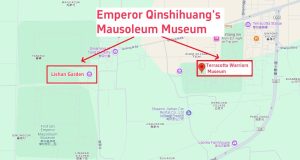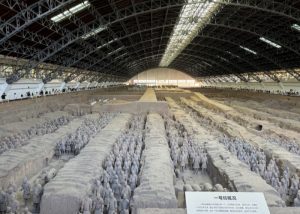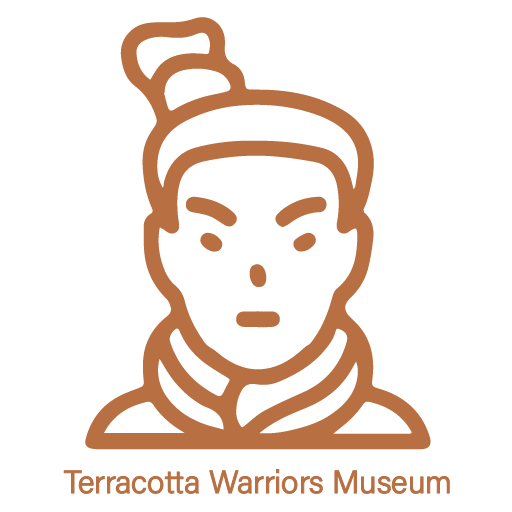The Emperor Qinshihuang’s Mausoleum Museum consists of two main sections: Terracotta Warriors Museum, and Qin Shi Huang’s Mausoleum (Lishan Garden). The museum features the Terracotta Warriors and Horses pits along with exhibition halls for cultural relics. In contrast, the site park includes the mausoleum itself, a hall for bronze chariots and horses, and numerous funerary pits.

What to See in Terracotta Warriors Museum?
Pit 1 at Terracotta Warriors Museum

- Pit 1 of the Terracotta Army is a significant archaeological site related to Emperor Qin Shi Huang. This rectangular pit measures 230 meters in length and 62 meters in width, covering an area of 14,260 square meters.
- Discovered in 1974, it features a military formation with chariots and infantry arranged in an organized manner.
- Approximately 6,000 terracotta figures and horses are believed to be present in this pit, with over 1,000 having been excavated so far. The layout includes a vanguard, main body, flanks, and rear guard, showcasing a well-structured military arrangement.
Pit 2 at Terracotta Warriors Museum

- Pit 2 of the Terracotta Army is located about 20 meters north of Pit 1 and covers an area of approximately 6,000 square meters, shaped like a carpenter’s square.
- Discovered in 1976, this pit contains over 1,300 pottery figure sand horses.
- The military formation in Pit 2 is made up of four units, representing a diverse multi-service force that includes crossbowmen, chariot soldiers, and cavalry.
- A variety of cultural relics have been found here, such as unique general figures and saddled horse figures. This formation is more complex than those in the other pits, showcasing a complete range of military branches.
Pit 3 at Terracotta Warriors Museum

- Pit 3 of the Terracotta Army, located northwest of Pit 1, is shaped like a concave and measures 17.6 meters wide and 21.4 meters long, covering an area of 524 square meters, making it the smallest of the three pits.
- Discovered in 1976, this pit contains 72 pottery figures and horses, representing the command center of the Qin army’s battle formation.
- The pit 3 is unique as it has not suffered fire damage, allowing for more visible remnants of colored paintings on the unearthed figures. The soldiers are positioned in a way that symbolizes their role in a military command tent, highlighting their function in directing troop movements during battles.
What to See in Qin Shihuang’s Mausoleum(Lishan Garden)?
- Qin Shi Huang’s Mausoleum, the burial site of first Qin Emperor(offical name: Ying Zheng), is located at the northern foot of Lishan Mountain, about 5 kilometers east of Lintong District in Xi’an, Shaanxi Province.
- It is approximately 2 kilometers near the Terracotta Army Museum. The construction began in the first year of Qin emperor succeeded the throne and lasted for 39 years to his death, creating a vast and impressive burial
- The mausoleum features both inner and outer city walls surrounding the central tomb mound. While the underground palace remains unexplored, it is surrounded by numerous burial pits, including the famous Terracotta Army, Pit K9901(Acrobat Figures), Pit K0006 (Civil Official Figures), and Bronze Chariots & Horses Exhibition Hall.
- Qin Shi Huang’s Mausoleum is not just a royal tomb but also a significant cultural and historical resource, providing insights into the Qin Dynasty’s politics, economy, military, and culture.
Bronze Chariots & Horses

- Bronze Chariots & Horses are displayed in the Emperor Qin Shi Huang’s Mausoleum Site Museum. These artifacts were unearthed between June 1978 and December 1980, located on the western side of the emperor’s burial mound.
- 1 Chariot is the vanguard. No. 2 Bronze Chariot and Horses is larger than No. 1 and and the chariot is enclosed.
- Both chariots are made of bronze and are scaled to half the size of actual chariots and horses, showcasing remarkable craftsmanship from over two millennia ago.
Terracotta Warriors Temporary Exhibition Hall
- The Terracotta Warriors Temporary Exhibition Hall offers a fascinating glimpse into the world of ancient China. This hall regularly hosts thematic exhibitions that showcase artifacts related to the Terracotta Warriors, their historical context, and archaeological discoveries.
- Notable exhibitions include the journey of the Terracotta Warriors’ discovery in 1974 and the intricate craftsmanship behind these lifelike figures.
- Additionally, rotating exhibitions cover various topics, such as ancient weaponry and Qin Dynasty culture, often in collaboration with other museums. That can deepen your understanding of this remarkable archaeological site through engaging displays and educational experiences.
Further Reading:

